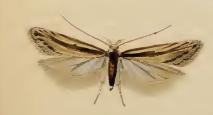
Cytisus is a genus of flowering plants in the family Fabaceae, native to open sites in Europe, western Asia and North Africa. It belongs to the subfamily Faboideae, and is one of several genera in the tribe Genisteae which are commonly called brooms. They are shrubs producing masses of brightly coloured, pea-like flowers, often highly fragrant. Members of the segregate genera, Calicotome, Chamaecytisus, and Lembotropis are sometimes included in Cytisus.

Cytisus scoparius, the common broom or Scotch broom, is a deciduous leguminous shrub native to western and central Europe. In Britain and Ireland, the standard name is broom; this name is also used for other members of the Genisteae tribe, such as French broom or Spanish broom; and the term common broom is sometimes used for clarification. In other English-speaking countries, the most common name is "Scotch broom" ; however, it is known as English broom in Australia.

Cytisine, also known as baptitoxine, cytisinicline, or sophorine, is an alkaloid that occurs naturally in several plant genera, such as Laburnum and Cytisus of the family Fabaceae. It has been used medically to help with smoking cessation. Although widely used for smoking cessation in Eastern Europe, cytisine remains relatively unknown beyond it. However, it has been found effective in several randomized clinical trials, including some in the United States and a large one in New Zealand, and is being investigated in additional trials in the United States and a non-inferiority trial in Australia in which it is being compared head-to-head with the smoking cessation aid varenicline. It has also been used entheogenically via mescalbeans by some Native American groups, historically in the Rio Grande Valley predating even peyote.

Cytisus striatus is a species of flowering plant in the legume family known by the common names hairy-fruited broom and Portuguese broom. This plant is native to the west of the Iberian Peninsula and northwestern Morocco.

Rhodostrophia vibicaria, the common pink-barred, is a moth of the family Geometridae. The species can be found in the Palearctic realm.

Cytisus multiflorus is a species of legume known by the common names white broom, white spanishbroom and Portuguese broom.
Cydia medicaginis, the alfalfa moth, is a moth of the family Tortricidae. It is found in northern and central Europe, Transcaucasus, Kazakhstan and from western Russia to southern Siberia.

Amphipyra effusa is a moth in the family Noctuidae. It is found from the Mediterranean region and Asia.
Phyllonorycter scopariella is a moth of the family Gracillariidae. It is found from Ireland to central Russia and from Denmark to France, Italy, the Czech Republic, Slovakia and Ukraine. It is also known from Portugal.

Phyllonorycter staintoniella is a moth of the family Gracillariidae. It is found from Sweden to the Pyrenees, Sardinia, Italy and Bulgaria and from Great Britain to Poland and Romania.

Micrurapteryx kollariella is a moth of the family Gracillariidae. It is known from all of Europe, except the British Islands and Fennoscandia.

Agonopterix assimilella is a moth of the family Depressariidae. It is found in most of Europe.

Agonopterix atomella is a moth of the family Depressariidae. It is found in most of Europe.

Mirificarma mulinella is a moth of the family Gelechiidae. It is found in most of Europe, except Finland, the Baltic region and part of the Balkan Peninsula. It has also been recorded from North Africa.
Mirificarma interrupta is a moth of the family Gelechiidae. It is found in Portugal, Spain, France, the Benelux, central Europe, Romania and North Africa.

Bembecia uroceriformis is a moth of the family Sesiidae. It is found in France, Spain, Portugal, Switzerland, Italy and most of the Balkan Peninsula. It is also found in North Africa and from Asia Minor to the Caucasus.

Cytisus 'Lena' is a hybrid broom of two species of Cytisus, Cytisus scoparius × Cytisus dallimorei, and is known as 'Lena' after the German hybridizer, Herr Lena. He is credited with a handful of other classic broom cultivars. It is a small deciduous shrub with slender green shoots and small trifoliate leaves. It has fragrant flowers of brown-red edged with gold, or deep crimson with a light yellow keel.

Cytisus hirsutus is a perennial plant belonging to the genus Cytisus of the family Fabaceae.

Cytisus nigricans, the black broom, is a species of flowering plant in the subfamily Faboideae of the family Fabaceae. Growing 3–5 ft (0.91–1.52 m) tall, it is a slender deciduous shrub with erect branches. Masses of brilliant yellow, slightly fragrant pea-like flowers appear in long racemes on the current year's growth in summer and early autumn.

Genisteae is a tribe of trees, shrubs and herbaceous plants in the subfamily Faboideae of the family Fabaceae. It includes a number of well-known plants including broom, lupine (lupin), gorse and laburnum.











